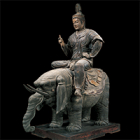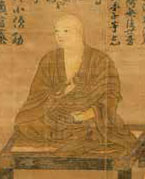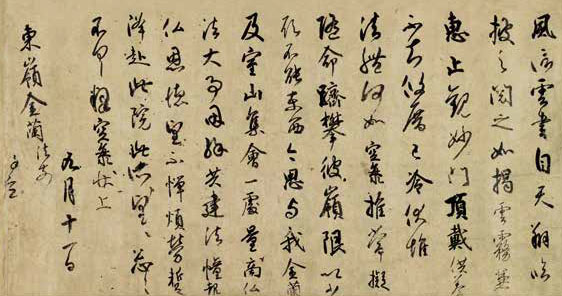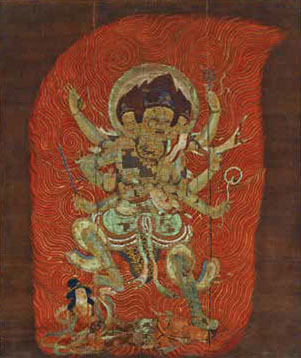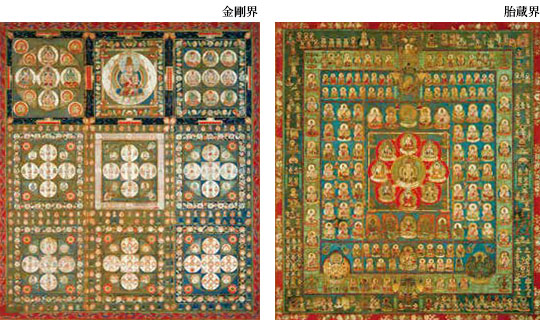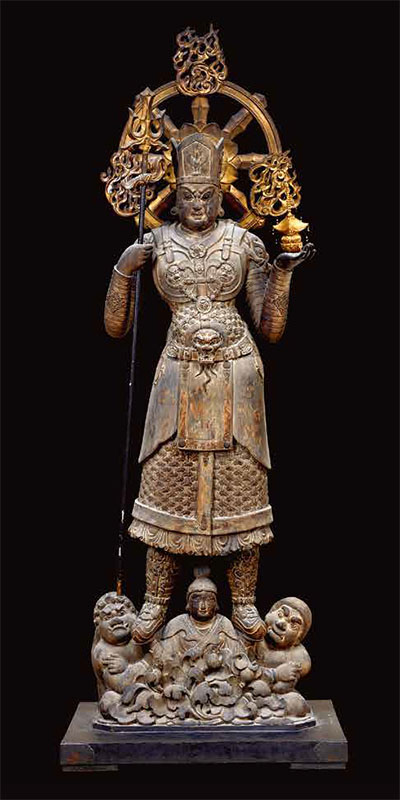1089ブログ「国宝 東寺―空海と仏像曼荼羅」展覧会の見どころなどを紹介しています。
東京国立博物館 資料館 特別展「国宝 東寺―空海と仏像曼荼羅」関連図書コーナー設置
展覧会のみどころ
空海
讃岐国(さぬきのくに、現在の香川県)の生まれ。中国に留学して密教を学び、帰国後、真言宗を開いて東寺や高野山を拠点に密教を広めました。密教の理解には造形物が不可欠という師の教えに従い、曼荼羅や彫刻などの制作を指導しました。弘法大師とも呼ばれ、空海自身が信仰の対象となっています。優れた書家としても知られています。
重要文化財 弘法大師像(談義本尊)(部分)
賛 伝後宇多天皇筆 鎌倉時代・14世紀 京都・東寺蔵
展示期間:3月26日(火)~4月21日(日)
第1章 空海と後七日御修法(ごしちにちみしほ)
空海は密教を求めて31歳で中国に渡り、約2年間の滞在でそのすべてを修めました。806年に帰国した後、823年に東寺を賜り、真言密教の根本道場としました。東寺には空海が中国から持ち帰った絵画や工芸品、空海の書の中でも最も格調高い「風信帖(ふうしんじょう)」が残っています。 空海は、正月に宮中で修される後七日御修法を始めました。現在は東寺で行われますが、真言宗で最も重要で、かたく秘された儀式です。本章では、後七日御修法の堂内の様子を再現して紹介します。
国宝 風信帖(ふうしんじょう)(第一通)(部分)
空海筆 平安時代・9世紀 京都・東寺蔵
展示期間:3月26日(火)~5月19日(日)
空海から最澄(さいちょう)に宛てた3通の書状を貼り継いだもので、第一通書き出しの「風信雲書…」の文言から「風信帖」と通称される。付属の寄進状により、もと延暦寺にあったが南北朝時代に東寺に寄進されたことが知られる。平安時代仏教史の基本史料として貴重であるとともに、壮年期の空海を代表する筆跡であり、書道史上も古来珍重されてきた。
国宝 密教法具(みっきょうほうぐ)
中国 唐時代・9世紀 京都・東寺蔵
金剛盤の上に五鈷鈴(ごこれい)と五鈷杵(ごこしょ)を据えた密教法具のセット。密教ではこうした組法具が修法壇(すほうだん)に置かれた。特にこの法具は、空海が帰国するに際して、師の恵果(けいか)が授けた法具類の一部と考えられるもので、空海請来の霊物として尊崇されてきた。宮中の真言院で行われた後七日御修法をはじめとする、重要な法会に用いられ、今も東寺灌頂院(かんじょういん)の道場で行われる後七日御修法では、大阿闍梨(だいあじゃり)の道具として重要視されている。
国宝 降三世明王(ごうざんぜみょうおう)
(五大尊像(ごだいそんぞう)のうち)
平安時代・大治2年(1127) 京都・東寺蔵
展示期間:3月26日(火)~4月21日(日)
鳥羽院(とばいん)の命で描かれた、平安時代後期貴族の美意識が凝縮した作例。東寺宝蔵(ほうぞう)にあった宮中真言院後七日御修法の本尊画像が、大治2年の火災で失われたため、新たに制作されたのが本画像。多面多臂(ためんたひ)の醜怪な明王の姿を嫋(たお)やかに表す。
展覧会のみどころトップへ
第2章 真言密教の至宝
真言密教では、造形や儀礼、荘厳(しょうごん)の仕方において、それまでの仏教教団とは大きく異なる形式をとります。造形の上では、大日如来を中心として多くの如来・菩薩・明王・天などを集合的に描いて密教の世界観を表した両界曼荼羅図や、如来・菩薩などの姿形や手で結ぶ印(いん)の形などの細かな規則を図示した図像を重要視します。また、儀礼の中で鳴り物の楽器を用いることも特徴です。
本章では、両界曼荼羅など東寺に伝わる密教独特の造形の名品をご覧いただきます。
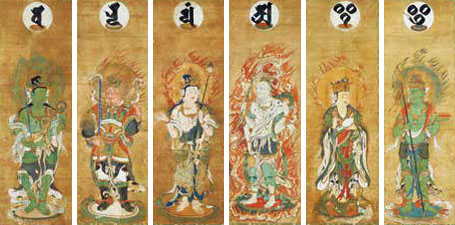
展示期間:4月23日(火)~5月12日(日)
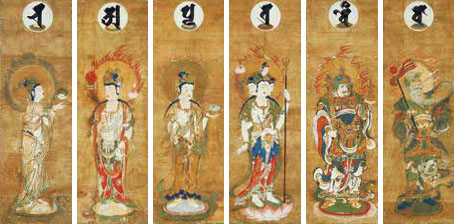
展示期間:5月14日(火)~6月2日(日)
国宝 十二天屛風(じゅうにてんびょうぶ)
平安時代・建久2年(1191) 京都・東寺蔵
密教の灌頂(かんじょう)儀礼で用いられた屛風。ほとばしる描線、明度の高い彩色の本図は、従来の十二天像に対して「新様(しんよう)」と呼ばれ、新来の宋代絵画の影響が色濃い。絵は宅磨勝賀(たくましょうが)筆、上部の種子(しゅじ)(梵字(ぼんじ))は仁和寺御室(にんなじおむろ)守覚法親王(しゅかくほっしんのう)筆と伝える。
国宝 両界曼荼羅図(りょうかいまんだらず)
(西院曼荼羅[伝真言院曼荼羅](さいいんまんだら でんしんごんいんまんだら))
平安時代・9世紀 京都・東寺蔵
展示期間:4月23日(火)~5月6日(月・休)
現存最古の彩色両界曼荼羅図。表情や体軀の描写、強い暈取(くまど)りなどにインド風が強く表れた画風が特徴である。宮中真言院で使用されたという伝承から「伝真言院曼荼羅」の名称があるが、近年、修理銘から東寺の西院(さいいん)で使用されたものであることが判明した。
展覧会のみどころトップへ
第3章 東寺の信仰と歴史
平安京遷都にともなって建立された東寺には、1200年にわたり寄せられた篤い信仰とその歴史を物語るさまざまな宝物が伝わります。
本章では、羅城門(らじょうもん)伝説に彩られた毘沙門天立像(びしゃもんてんりゅうぞう)にはじまり、空海ゆかりの舎利信仰や、八幡信仰を伝える遺品、東寺の歴史や宝物についてまとめられた『東宝記(とうぼうき)』に代表される書跡や古文書など、東寺の信仰と歴史を今日に伝える宝物の数々をご覧いただきます。
国宝 兜跋毘沙門天立像(とばつびしゃもんてんりゅうぞう)
中国 唐時代・8世紀 京都・東寺蔵
中国・唐時代に造られた、異色の毘沙門天像。腰が高い細身のスタイルと、中央アジア風の甲(よろい)が特色で、日本でも各地で模刻が造られるなど信仰を集めた。平安京の羅城門に安置され、都を守護したと伝えられる。
 国宝 後宇多天皇宸翰 東寺興隆条々事書(ごうだてんのうしんかん とうじこうりゅうじょうじょうことがき)
国宝 後宇多天皇宸翰 東寺興隆条々事書(ごうだてんのうしんかん とうじこうりゅうじょうじょうことがき)(部分)
鎌倉時代・徳治3年(1308) 京都・東寺蔵
展示期間:3月26日(火)~4月30日(火)
真言僧としての修法の伝授を受けた後宇多天皇が、東寺に修行僧50人を置き、僧坊や寺領を整備して真言密教の興隆を図るように指示したもの。この後、山城国上桂荘(かみかつらのしょう)、八条院町(はちじょういんのまち)など、荘園や洛中の土地の寄進が行われ、中世寺院としての東寺再興のきっかけとなった。
展覧会のみどころトップへ
第4章 曼荼羅の世界
曼荼羅とは、仏の世界を表したもので、インドで成立しました。複雑な密教の世界観を視覚的に表すことから布教に適し、アジア各地に普及しました。空海は長安(ちょうあん)で師恵果(けいか)から両界曼荼羅(りょうかいまんだら)を伝授されますが、「密教は奥深く、文章で表すことは困難である。かわりに図画をかりて悟らないものに開き示す」(『御請来目録(ごしょうらいもくろく)』)と語るように、イメージの力を重視しました。その到達点ともいえるのが、講堂に安置された21体の仏像から構成される立体曼荼羅です。
重要文化財 金剛虚空蔵菩薩(こんごうこくうぞうぼさつ)・法界虚空蔵菩薩(ほっかいこくうぞうぼさつ)
五大虚空蔵菩薩坐像のうち
中国 唐時代・9世紀 京都・東寺蔵
もと京都・山科(やましな)の安祥寺(あんしょうじ)に伝わり、空海の孫弟子である恵運(えうん)が中国からもたらしたという。五体全てが現存し、台座の馬や獅子まで制作当時の姿を伝えるのは貴重。

仏像曼荼羅イメージ 京都・東寺蔵
展覧会のみどころトップへ

